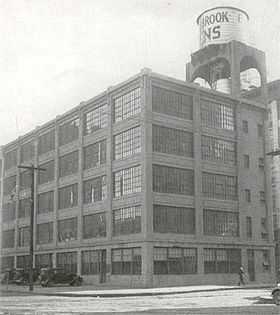Esterbrook
 | |
| Private | |
| Industry | Writing instruments |
| Fate |
Acquired by Venus Pencils, then dissolved |
| Successor | Berol |
| Founded | 1858 |
| Founder | Richard Esterbrook |
| Defunct | 1972 |
| Headquarters | Camden, New Jersey, USA |
Area served | Worldwide [1] |
Key people | Richard Esterbrook |
| Products | Dip pens, Fountain pens |
Richard Esterbrook was the largest pen manufacturer in United States, having reached a record of producing 216,000,000 pens a year.[1]
History
The beginning

Richard Esterbrook (1812-1895 [2]) was a Cornish Quaker from England who saw an opportunity in the United States to manufacture steel pens. In 1856 he traveled to the US to set up shop as "The Steel Pen Manufacturing Company". In 1858 he was able to establish himself as the sole pen manufacturer in the USA and he changed the company name to "The Esterbrook Steel Pen Mfg. Co.", with just 15 employees and settled down in Camden, New Jersey. At the time, two of the four pen companies located in the United States were situated in Camden. Besides Esterbrook, the first in the country, the C. Howard Hunt Pen Company at 7th and State streets produced pens, pencil sharpeners and allied products and employed 125 workers. At its height, the Esterbrook plant had 450 workers and produced 600,000 pens a day.[3]
There were no men in this country learned in the pen trade and no suitable machinery, so it was necessary to design and build all machines. Only fifteen people were on the first payroll, but the growth of the company has been a steady one. The buildings had been added to from time to time and in 1912 a five-story concrete building was erected nearly doubling the size of the plant. Automatic Machines had replaced hand work, and the output greatly increased.
Development

Quality was a key factor in his success. His steel pens were versatile, long lasting, and came in many different styles to fit the varied writing styles of the public. Sadly, Richard Esterbrook didn't see the "empire" his company was to become as he died in Atlanta on October 12, 1895.
Just one year after his death, in 1896 the company started an Esterbrook branch in England to join the ranks of the other main pen manufactures in Birmingham. By 1920 the fountain pen was fast becoming more popular amongst people who were tired of dipping the pens into ink. To meet this demand the company manufactured its first fountain pen. In 1930 the company sought less expensive means of manufacturing pens because gold and jewel tips were too expensive and in this same year they began selling fountain pens in England. The Esterbrook Company began using the metal Iridium which they called "Durachrome". To meet the fountain pen demand the company reformed as "The Esterbrook Hazel Pens Ltd". In 1940 war had come to strike a blow at the Esterbrook company.
Decline
In 1947 the company bought out John Mitchell (which had been established in 1822 as the World's first manufacturer to cut nibs by machine) and then acquired Hazell Pen Co. The company re-formed again as The Esterbrook Pen Company. Some time after this the company ceased production of dip pen nibs permanently. They had also started decreasing the quality of the dip pens in almost every area including construction, and materials.
The post war years had seen a decline particularly in the export trade to the traditional markets of the British Empire. As those countries gained independence due to American aid, they had more dollars to spend in the United States than pounds in the United Kingdom.[3]
The company continued to thrive until the beginning of 1960 when it started to see a decline in export trades with England. In 1967 the Esterbrook Empire was bought out by the Venus Pencil Company and thus the name changed to Venus Esterbrook, which continued to produce replacement nibs for fountain pens. There were numerous administrative changes and moves and eventually their final base of operations was vacated in 1972, though the building still stands today. The company, in one form or another can now be traced to Berol Ltd.[2][4][5] In 2014, Harpen Brand Holdings, LLC announced the revival of the Esterbrook Pen brand after securing the trademark rights for the Esterbrook brand name.
Artists related with Esterbrook
The famous Disney artist Carl Barks was an enthusiastic user of Esterbrook pens. He particularly used a Nº 356 model to ink and letter his famous Donald Duck comic-book pages.[3][6]
| “ | "...I drew direct onto the drawing paper with a Scripto light blue pencil, and inked with a 356 Esterbrook pen. My wife inked the dialogue with an A-5 or B-6 Speedball, and blacked the solid areas with a #2 sable brush." (Letter to Michael Barrier, January 14, 1967) [7] | ” |
| “ | "...I used a #356 Esterbrook art and drafting pen which could do everything from thin 'fadeaways' to broad accented curve sweeps on foreground circles such as the ducks' forms. The trick of breaking in a new pen, I discovered, is to soak it for several minutes in the ink bottle. Then wipe off the ink and the pen's varnish. For some weird reason most new pens then start out flexible and free-flowing..." (Letter to Scott Matheson, March 21, 1973) [7] | ” |
References
USA TODAY Feature Article On The Revival of the Esterbrook Pen Brand by Harpen Brand Holdings, LLC http://www.usatoday.com/story/money/business/2015/02/05/reviving-the-pen-that-wrote-american-history/22941265/
External links
- Berol website
- Vintage Esterbrook pens site with extensive resources
- Vintage Esterbrook pens site
- New Esterbook Company Official Website
| ||||||||||||||||||||||||||||||||||||||||||||||||||||||||||||||||||||||